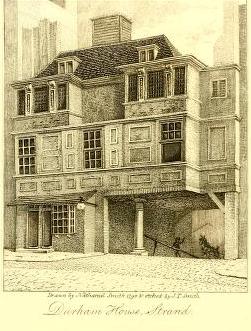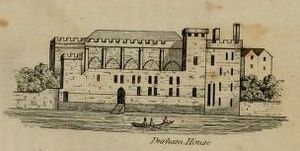Durham House, London facts for kids

Durham House was a very grand house in London. It was the official home, or town house, for the Bishop of Durham. This important building was located on the Strand street. Its beautiful gardens stretched all the way down to the River Thames.
Contents
History of Durham House
Building a Grand Home
Bishop Thomas Hatfield built the amazing Durham House around 1345. It was a very fancy place. The house had a large chapel for prayers. It also had a huge great hall with a high ceiling. This hall was supported by strong marble pillars.
On the side facing the Strand street, there was a gatehouse. This led into a big courtyard. The main hall and chapel were near the entrance. The private rooms looked out over the River Thames. People described Durham House as a palace fit for a prince. Even King Henry IV and his son, Prince Henry (who later became King Henry V), stayed there with their large groups of followers.
Royal Residents and Famous Guests
Durham House was still the Bishop's palace for a long time. However, it also hosted many important royal figures. Catherine of Aragon lived there for a while. This was between her marriages to Arthur, Prince of Wales and King Henry VIII.
Later, Bishop Cuthbert Tunstall gave the house to King Henry VIII. The King promised to give the Bishop other homes in return. But Henry VIII never kept his promise.
Anne Boleyn lived in Durham House in 1532. This was when King Henry VIII was trying to marry her. They married in 1533. Henry then gave Durham House to his daughter, Lady Elizabeth. She was allowed to live there for life. Henry's son, King Edward VI, later confirmed this gift. This meant Bishop Tunstall lost his palace.
However, when Queen Mary became queen, she took the house from Lady Elizabeth. She gave it back to Bishop Tunstall. It was clear he needed a home in London.
A famous event happened at Durham House on May 21 or 25, 1553. Lady Jane Grey, who was Queen of England for only "Nine Days," got married there. She married Guilford Dudley.
When Elizabeth became Queen, she took Durham House back again. She kept it until 1583. Then, she gave it to Sir Walter Raleigh. Sir Walter spent £2,000 to fix up the house. He lived there until Queen Elizabeth died.
A writer named John Aubrey remembered Sir Walter Raleigh's study. It was in a small tower looking over the Thames. From there, Raleigh could see Westminster, Whitehall Palace, and the Surrey hills.
It was at Durham House that Raleigh hosted Manteo and Wanchese. They were the first Native American Algonquin people to visit England from the New World. In 1584, Sir Walter Raleigh sent ships to Roanoke island. This was to explore and settle the new land of Virginia. Early meetings with the native people were friendly. Even though it was hard to talk, the explorers convinced "two strong men, whose names were Wanchese and Manteo" to come back to London with them.
Once in England, the two Native Americans became very famous at the royal court. But Raleigh wanted to learn about Virginia. He limited who could meet them. He asked the scientist Thomas Harriot to learn their Carolina Algonquian language. Harriot even created his own phonetic alphabet to help with the translation.
After Queen Elizabeth died, Raleigh lost his power at court. Tobias Matthew, who was then the Bishop of Durham, took Durham House back. He offered it for use by the Privy Council, a group of royal advisors. The new king, James I, agreed to this.
The House Falls Apart
Neither Bishop Matthew nor any bishops after him lived at Durham House. Because of this, the house started to fall apart. The stables were torn down to build the New Exchange. This was a market with shops for hat makers and seamstresses.
In the 1630s, Durham House was a meeting place for the Durham House Group. This group included important church leaders like Richard Neile and William Laud.
The best part of the house was rented by Thomas Coventry, 1st Baron Coventry. He was known as "Lord Keeper Coventry." He died there in 1640. What was left of the house was later taken by Philip Herbert, 5th Earl of Pembroke. He rented it from the Bishop for £200 a year. He planned to build a grand new house there, but it never happened. Pembroke hired the architect John Webb, who drew many plans for the house. Instead, Pembroke built on a street called Durham Street. This street ran through the old house's remains down to the River Thames. A small part of it still exists today. It is a short, steep street that goes under the headquarters of the Society of Arts.
The very last parts of the old ruins were cleared away when King George III was king (1760-1820). This was when the brothers Robert Adam and James Adam built the Adelphi Buildings. They raised the whole area on tall arches.


